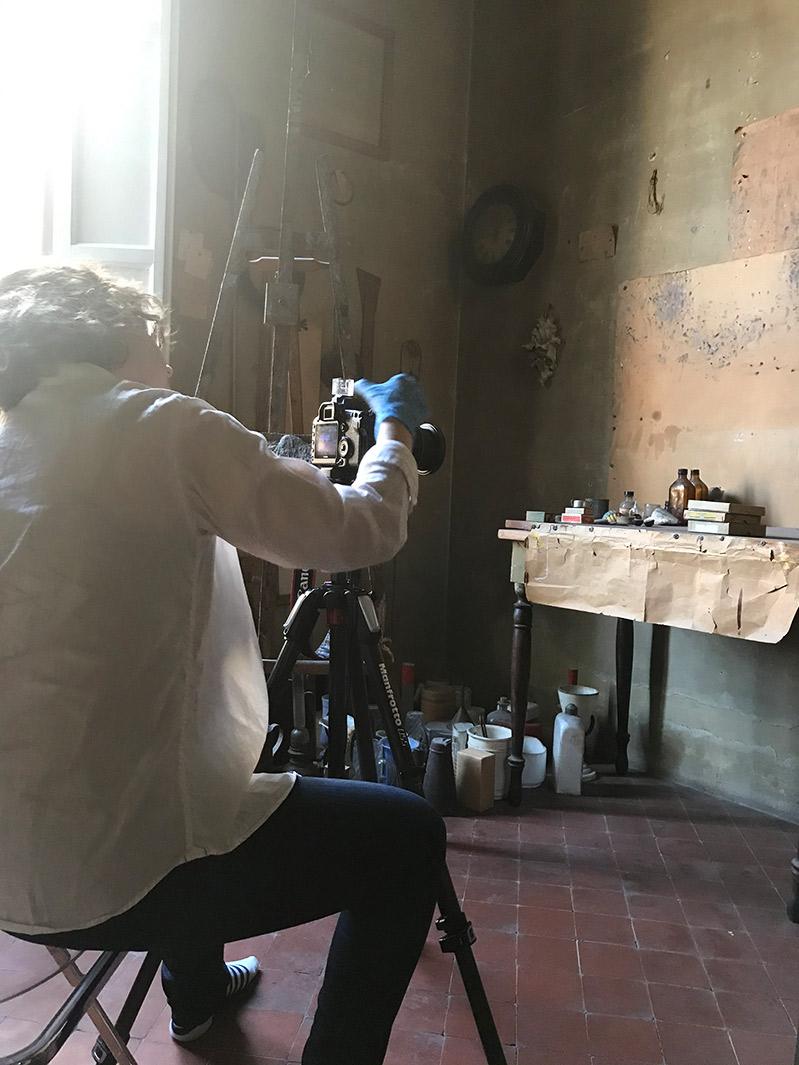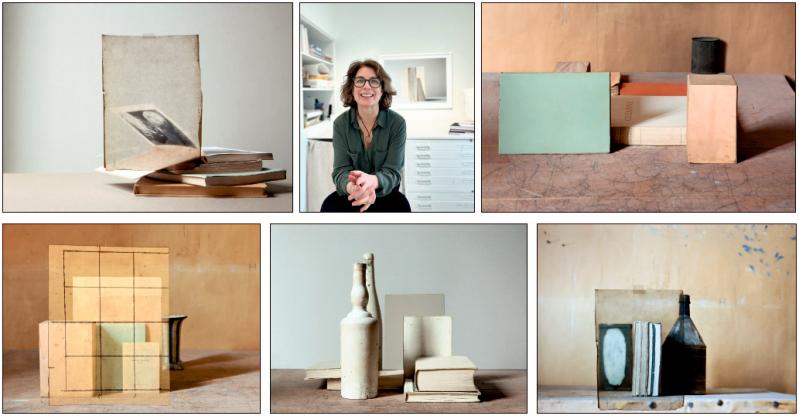With few exceptions, Giorgio Morandi (1890-1964) appears to have spent almost all of his life in Bologna, Italy. Although the city is known for its art academy, it is off the beaten path of the typical European grand tour. Yet the artist managed to absorb much from his contemporaries in Paris and other early modern art capitals, becoming part of movements in his own country like Futurism and Metaphysical Painting.
Where did he learn about artists such as Picasso and Cezanne? Mary Ellen Bartley has a theory that the exposure came mostly from books. The Sag Harbor photo-based artist should know. Over the course of a residency at Casa Morandi interrupted by the Covid global shutdown and finished last year, she worked with some 600 books in his library and the objects in his studio, drawing inspiration for her latest photographic series, "Morandi's Books."
"I had the sense that the books were really important to him," she said recently in the back room of Yancey Richardson, the New York City gallery where she shows her work. She then read an essay by a Morandi expert who confirmed that the books were precious. "So it felt kind of charged historically and emotionally like that. It was an intimate connection."
Ms. Bartley remembers first seeing Morandi's work in books, and that's how he became an early influence on her aesthetic, which has been primarily Minimalist in nature. It wasn't until the Metropolitan Museum of Art's 2008 Morandi retrospective that she saw any significant number of paintings together, and it was an important catalyst for where she would go next. She began to seek objects that she could photograph in a quiet way, similar to how Morandi painted the objects he chose for his compositions.
In some of her earliest breakthroughs from around 2010, she turned her camera on the kind of bland paperbound monograph you might collect in a university bookstore for a theory-heavy seminar. Yet assembled together in stacked compositions or captured on the sides from either the spine or the page blocks in diffuse lighting, the mundane and blah caught fire and were transformed into something structural, geometric, subtly elevated. Her early photos rekindled Minimalism without irony, while imbuing all with a very personal and rigorous vision.
She went on from there, gaining recognition and exhibitions of her work (including at the Drawing Room in East Hampton, where selections from the latest series are on view through March 12) that continued to have books as the focus. She ventured on from her own collection as subject to those of Robert Wilson, Jackson Pollock and Lee Krasner, and the Beales of Grey Gardens.
In the spring of 2018, she visited Casa Morandi, which was both the house and studio of the artist and now operates as a museum. On a tour with a curator, she discovered a closet of books and "it was like experiencing a miracle." She understood what her next project should be and set about making a residency there a reality.
That is what led her to Bologna as Italy began to be a hotspot early in the Covid-19 wave across Europe. She found herself getting out a day or two ahead of the country's full shutdown. During the residency, she spent most of her time in the library with very limited access to the studio. "I had to have a curator with me and Covid had started. The museum was closing to the public and the red line of Northern Italy was coming closer and closer. It was very stressful," she recalled.
Back at home, "I had the photos I had taken, but . . . I didn't have the full project yet, and I knew it. I had this dream opportunity, right? And then I go there and it was incomplete."

Part of her goal for the project was to incorporate some of Morandi's studio objects in her compositions, which time did not allow. She knew she had a beginning, but without being able to return, she was blocked on how to make the images a series. Her frustration building, she broke through the block during a residency at The Church in Sag Harbor last winter. "I started adding collage elements as a workaround," she said, "to address the frustration."
Many of Morandi's books had well-worn glassine protective covers, and she found a few on her own books at home. Making the connection, she taped a piece of her own glassine to her computer monitor, where the photographs were displayed. She liked what she saw and began taking photos of the original compositions through the glassine. The experiment led her to try adding other collaged elements, including opaque pieces of paper that covered both empty parts of the composition as well as elements of it. She also cut holes in vellum, which provided a similar scrim-like effect and highlighted the parts of the image seen through the opening -- or, aptly, the aperture.
It was the breakthrough she needed. "It had a lot going on for me that just loosely and conceptually made sense." At the same time, it was important for the moment. The idea of "veiling, protecting, and being kept from something" was often felt and still can be in the post-Covid world. The vellum and glassine also work "as a filter or framing device and it looks like a patina."
She then received permission to return to Casa Morandi. "When I went back, I went to the studio. I already had the ideas about collage and so I worked differently." She was able to employ some of Morandi's most familiar subjects in her own artwork, allowing them to enrich her compositions and make them more characteristic of the artist.
"Every time I do one of these library projects -- as opposed to just working in my studio with really cool books that I decide to photograph -- I have to come up with a strategy that honors them." She thinks about the books themselves, their placement, and how to make a collection out of their images.
The collage elements allow her (and the viewer) to look at the surface differently. Once you understand what is going on, which she offers clues to in her titles, you begin to question everything you're looking at in the composition. What are books and what is just paper, why do some elements recede and others project, are they on a table or hanging from the horizon?
"What I like about these interventions are that they cause you to pause and try to figure them out. They're disorienting." It also allowed her to play with space more than she could with just her camera, introducing an element of creativity in "the way painters might say, 'I'm gonna put a square way over there.' For me that was really fun."
Having familiarity with the Morandi space when she returned made it feel "really nice and kind of ordinary," she said. "What I realized, surrounded by all the vessels that he used, was how amazing he was." She felt viscerally the extraordinary "alchemy that happens between these pretty ordinary-looking objects -- some of them are really ugly -- becoming these iconic characters that he paints again and again. . . . If you didn't know his work, you would never get there. It's not obvious that those objects would have made those paintings."
Some might be tempted to fetishize them, but she didn't want to take photographs of the bottles, cans, vases, cups, and other items as an end in itself. The aim was to make compositions with them that would "empty them of meaning, yet allow them to be themselves. It's sort of a tricky thing."
Ms. Bartley will return to Bologna at least one more time. The next time will be to show the series at the Museo Morandi (a separate entity from the Casa, but both are part of the Museo d'Arte Moderna di Bologna), which will have it on view at the end of this year with the exact dates to be announced. A book, either a catalog or artist's book, will also mark the occasion.




